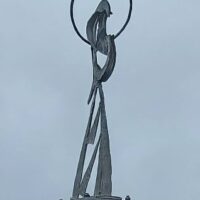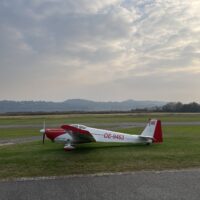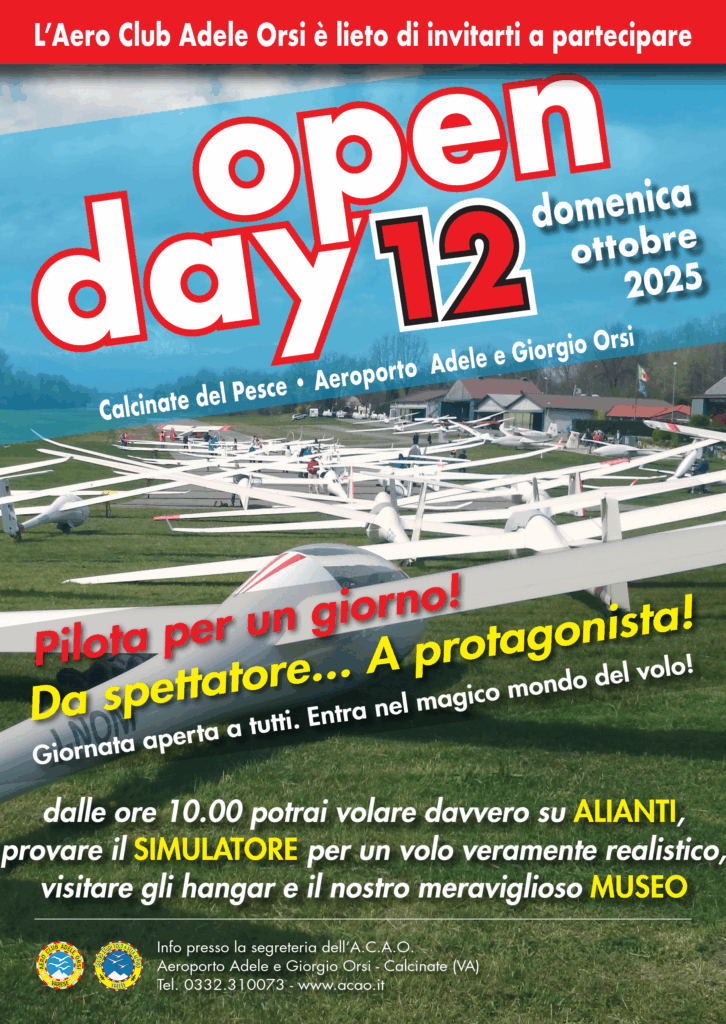 Practicing “gliding” means flying with a glider: an aeroplane without the use of mechanical propulsion devices. A good glider pilot sees the air that surrounds as a huge reservoir from which to draw the energy it needs. The forces of nature are at his disposal, if he has learned not to fear them but to respect them, listening to them and understanding their minimal signs with total attention. A glider is currently the highest practical expression of more than a century of knowledge of aerodynamics: the most modern lift /portanza generated by the wings is over 60 times bigger than the resistance opposed to the progress (we call this concept with the term “efficiency of 1 to 60”). In other words, for every 100 meters of altitude lost a glider flies 6 miles away. Even the designers of modern jet liner take aerodynamic extrapolated from studies of modern sailplanes.
Practicing “gliding” means flying with a glider: an aeroplane without the use of mechanical propulsion devices. A good glider pilot sees the air that surrounds as a huge reservoir from which to draw the energy it needs. The forces of nature are at his disposal, if he has learned not to fear them but to respect them, listening to them and understanding their minimal signs with total attention. A glider is currently the highest practical expression of more than a century of knowledge of aerodynamics: the most modern lift /portanza generated by the wings is over 60 times bigger than the resistance opposed to the progress (we call this concept with the term “efficiency of 1 to 60”). In other words, for every 100 meters of altitude lost a glider flies 6 miles away. Even the designers of modern jet liner take aerodynamic extrapolated from studies of modern sailplanes.
A glider can take off to use various devices or systems; for example, towed by an aeroplane through the traction exerted by a cable (even a couple of miles long) that wraps up quickly on a powerful winch fixed to the ground. Once in flight the glider, slowly but constantly, goes down. The potential energy possessed thanks to the position reached, is in fact converted into kinetic energy, hence travel speed, to overcome the aerodynamic resistence and glide in search of new energy. If the pilot is able to find an area where the air is not static, but rises up, and manages to keep his glider inside, then he goes up with it, gaining a heigher height. The wind is not the only responsible for the vertical movement of an air mass, the sun, on a beautiful day, warms the soil and the latter heats the air of a thin layer (a few tens of meters) in contact with it; like a balloon, the warmed air also tends to rise and it organizes in an invisible, narrow ascending column we call a “thermal”. The experienced pilot keeps his glider within the thermal long the longest possible, making a series of spirals just like soaring birds such as raptors (Rapaci) and storks. A normal thermal has a diameter of between 100 and 400 meters, and rises until it reaches an altitude of balance that also depends on the temperature difference with to the surrounding air; this often means climbing up to at least 1000 or even 3000 meters. And if the glider flies parallel to a slope invested by the wind, it will add to the thermal activity the dynamic of the wind that goes up after hitting the slope. Normally when you fly in the mountains, the two actions, thermal and dynamic, sum up. The vertical speed of this rise can be from 1 to 7 meters per second (3.6 to 25 km / h !). Even higher in some cases than the one of a powerful aero touring 4 seater equipped with an engine of 200 horsepower. The intangibility of the air can let one think that nature has modest energies, but if a cubic meter of air weighs 1.300 grams, then even the smallest thermal has a mass of more than a thousand tons. This huge mass of warm air then rises more quickly than a powerful lift and can surely lift a all the gliders and birds that enter the thermal. While in all of sports engine related, sooner or later, the thrust of the engine creates habit and stops to amaze, the emotion that takes the pilot gliding is intense and infinite: the atmosphere is alive and communicates feelings that let him feel very close the most majestic birds.
The glider pilot is not only a pilot, is a man with wings. Today, with his growing experience, a glider pilot can aspire to goals that seem surreal. The altitude world record is over 14,000 meters, but far more important is the one of distance: 2042 kilometers in a single day (or night without the sun’s energy, gliders do not fly); the average speed record over a distance of 500km is 205 km / h. None of these values is going to last long. Every year hundreds of attempts are made to establish new national or world records.In Italy, any good pilot, after a few years of experience, can fly for hundreds of miles in a normal day, without facing exaggerated costs and using a glider belonging to the fleet of his Club. What differentiates the model of a glider from another, is how long it can glide in still air at a constant speed. The greater distance is achieved by maintaining what is called the “speed of maximum efficiency”, which is a parameter specific to each model and is called the “efficiency”: the relationship between altitude and distance.
This makes it necessary, in the case of competitions, the subdivision into classes, in order to have homogeneous group performances. Today there are 6 classes, in which common parameters are defined. The “Club” class is formed by non- recent generation gliders with “efficiency” between 35 and 40. A retractable landing gear is allowed, but no addition of water in the ballast to fligh faster. The “Standard” class includes gliders with a wingspan of 15 meters, fixed profile, retractable landing gear and water ballast allowed. The efficiency is between 40 and 43. The “Race” class is characterized by a wingspan of 15 meters, has a variable profile: it has flaps that allow a slower spiral in flight and a faster flight. The landing gear is retractable and water in ballasts is allowed. The efficiency is between 43 and 45. The “18 meters” class differs from the “racing” only in the wingspan which is 18 meters. Efficiency is between 48 and 50. The “Open” class has no restriction of any kind, and the wingspan can be between 20 and 30 meters. These are gliders that reach the highest ratios between height and glide path, normally higher than 50 and, in newer ones, more than 60. Four years ago a new class was created: the “World class” in which all the gliders are the same and have the same weight at take-off: lighter pilots are forced to load weights fixed lead to compemnsate the difference with the heavier ones.
The FAI (Fédération Aéronautique International http://www.fai.org/) has defined a series of tests to qualify the experience of the pilots and the Gliding licence. These tests can be summarized as follows: 1. Licence and silver badge for the pilot who has achieved the following objectives in only two flights: 1st flight: –5 consecutive hours calculated starting from the release altitude 2nd flight: – Flight of at least 50 km with an elevation gain from the lowest point of at least 1000 meters (the release should be performed at a maximum altitude of 500 meters above the starting point).
Licence with gold badge for the pilot that has already achieved the silver badge, has subsequently achieved the following objectives within one or two flights: 1st: – flight of 300 km around 4 geographic points set up before takeoff. 2nd: Gain of height of at least 3000 meters. Gold badges can be added with diamonds, achieving each of the following objectives: 1st: – flight of 300 km around 3 geographical points set up before takeoff. 2nd: Gain of height of at least 5000 meters 3rd: – execution of a course of 500 km around 3 geographical points set up before takeoff. To finish I would like to extend an invitation to comeand visit our our fields, to see with your eyes these wonderful machines that enable man to fulfill one of his greatest dreams: flying! Yes, flying in the silence and trying to “do with the help of reason what birds do with their instinct”.









